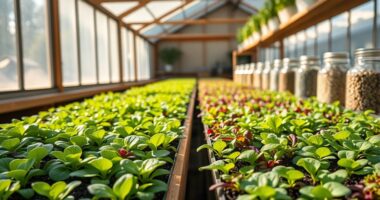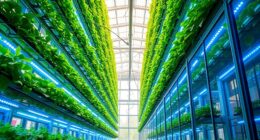To grow strawberries in a greenhouse, start by selecting the right varieties, like 'Albion' or 'Monterey,' for year-round yields. Use nutrient-rich, well-drained soil in containers with good drainage. Maintain temperatures between 21°C and 24°C during the day and guarantee at least six hours of natural light. Implement drip irrigation and monitor moisture levels closely. Regularly check for pests and maintain ideal humidity. Following these steps will set you on the right path to successful strawberry cultivation.
Key Takeaways
- Select disease-resistant strawberry varieties like 'Albion' or 'Monterey' for optimal yield and flavor in greenhouse conditions.
- Use nutrient-rich, well-drained soil with a pH of 5.5 to 7.0, and containers at least 6 inches in diameter.
- Maintain temperatures between 21°C to 24°C during the day and around 15°C at night for optimal growth.
- Implement drip irrigation and monitor soil moisture to ensure consistent hydration without overwatering.
- Regularly inspect for pests and utilize organic treatments, while maintaining ideal humidity and temperature levels to prevent infestations.
Variety Selection for Year-Round Production
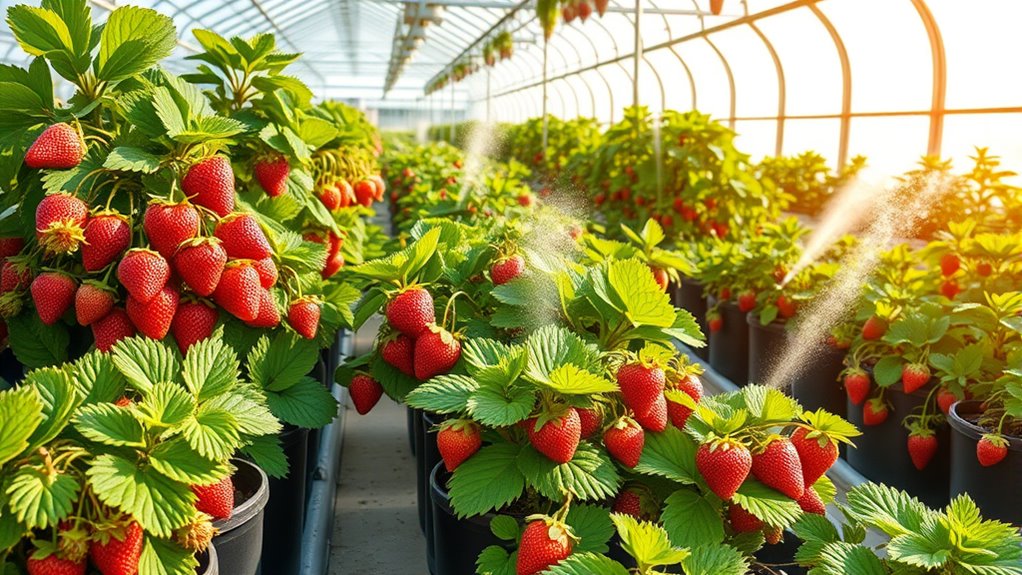
When selecting strawberry varieties for year-round production, it's crucial to take into account factors like yield, flavor, and disease resistance.
You may want to examine June-bearing varieties for their large, flavorful crops in early summer, while everbearing varieties can provide multiple harvests throughout the year.
Day-neutral varieties are perfect for consistent yields regardless of daylight, making them reliable in your greenhouse.
Also, keep in mind the ripening time and select cultivars like 'Albion' or 'Monterey', known for their early and consistent production.
Make sure you choose varieties that adapt well to your greenhouse environment and have strong disease resistance to prevent issues like Verticillium and Fusarium wilt.
Balancing market demand with these factors will enhance your production strategy.
Soil and Container Requirements
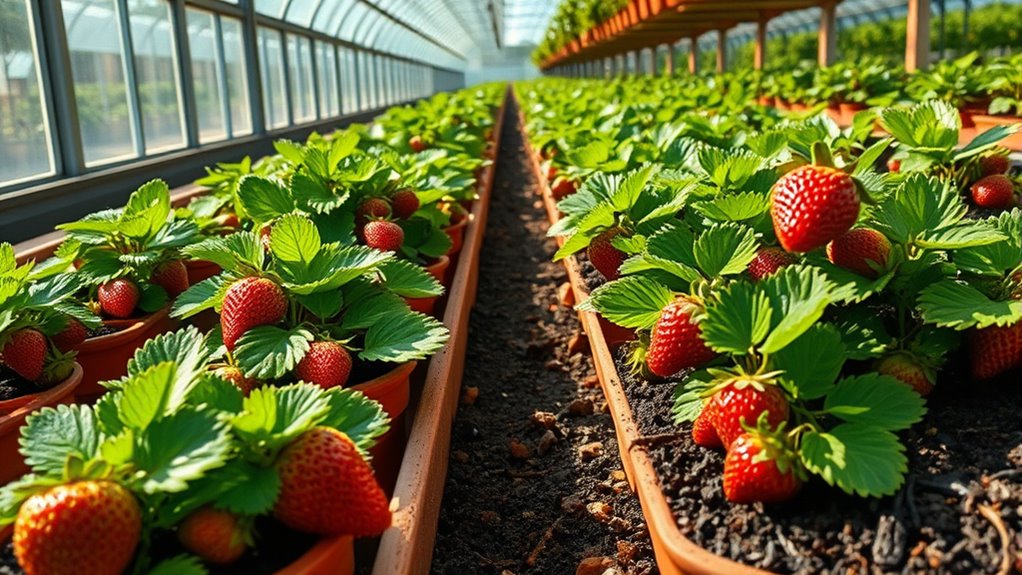
To successfully grow strawberries in a greenhouse, you need to focus on the right soil and container requirements. Use nutrient-rich, well-drained, acidic soil with a pH between 5.5 and 7.0. Incorporate high organic matter for healthy growth and fertilize with balanced organic compost twice a month.
Focus on nutrient-rich, well-drained, acidic soil with a pH of 5.5 to 7.0 for thriving greenhouse strawberries.
Mulch with straw to keep roots cool and moisture levels stable.
Select containers that are at least six inches in diameter and 12-15 inches deep, ensuring they've multiple drainage holes to prevent waterlogging. Terra-cotta or plastic pots work well, and hanging baskets or rain gutters can save space while accommodating several plants.
Always position the crown just above the soil to prevent rot and maintain ideal growing conditions.
Managing Environmental Conditions
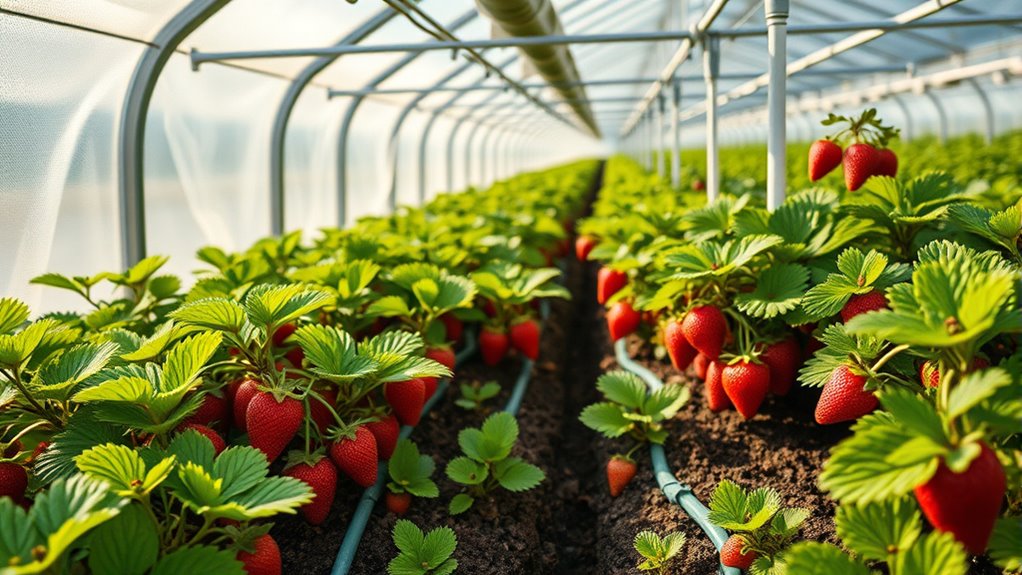
Managing environmental conditions in your greenhouse is essential for growing healthy strawberries. Aim for daytime temperatures between 21°C and 24°C (70°F to 75°F) and keep nighttime temperatures around 15°C (60°F).
Use ventilation systems like fans or open vents to prevent overheating. During winter, consider supplemental heating to maintain these ideal temperatures.
Ensure your strawberries receive at least six hours of natural light daily; some varieties may need up to 12 hours. In winter, supplement with LED grow lights.
Manage humidity carefully, as strawberries prefer consistent moisture but can suffer from root rot in waterlogged conditions. Regularly monitor humidity levels with hygrometers and maintain good air circulation to promote pollination and reduce disease risks.
Effective Irrigation and Water Management

Effective irrigation and water management are essential for maximizing strawberry yield in a greenhouse.
Consider implementing drip irrigation to deliver water directly to the roots, minimizing waste. Hydroponic systems offer precise control over both nutrients and water, making them ideal for high-tech setups. Ebb-flood systems help maintain suitable moisture levels while reducing disease risks.
Monitor soil moisture regularly to prevent overwatering and guarantee your plants get just what they need. Mulching retains soil moisture and decreases evaporation. Additionally, avoid overhead irrigation to reduce leaf wetness and prevent fungal diseases.
Regularly check and clean your irrigation systems to maintain efficiency and prevent bacterial growth. These strategies will help you grow healthier strawberries and increase your overall yield.
Nutrient and Fertilization Strategies
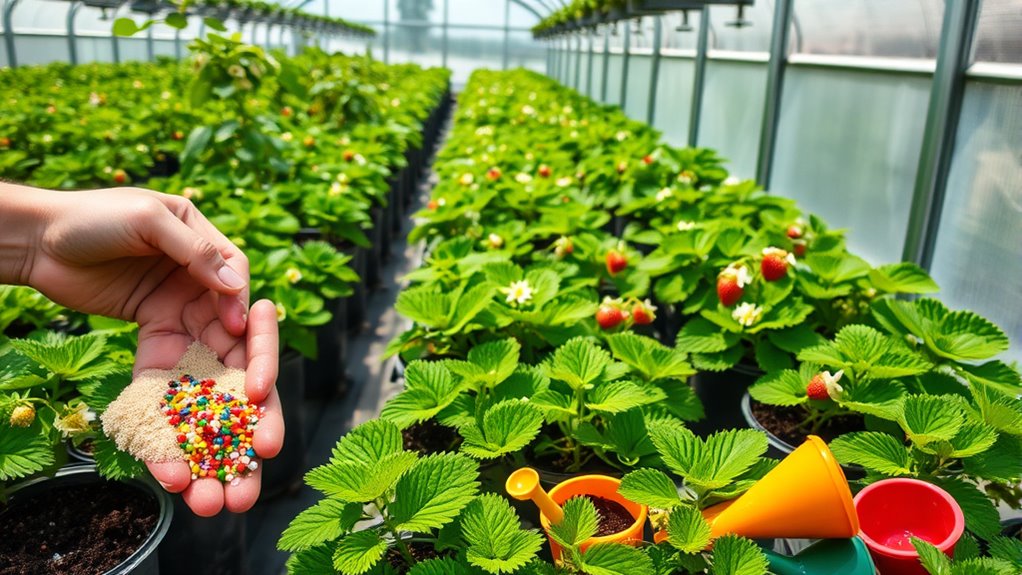
Maintaining ideal irrigation and water management sets the stage for successful nutrient uptake in strawberry plants.
To meet their nutrient needs, start with soil testing before planting to identify any deficiencies. During the growing season, use a balanced fertilizer every two weeks, switching to high potash options as fruiting begins. Incorporate organic composts or manure teas for sustainable nutrition.
Drip irrigation systems can enhance nutrient delivery efficiently. Pay attention to micronutrients like boron and zinc, crucial for fruit formation and set. Keep soil pH between 5.5 and 7.0, and guarantee it has about 3% organic matter.
Regularly monitor plant and soil health to adjust your fertilization strategy as needed for optimum growth.
Implementing Pest Management Techniques
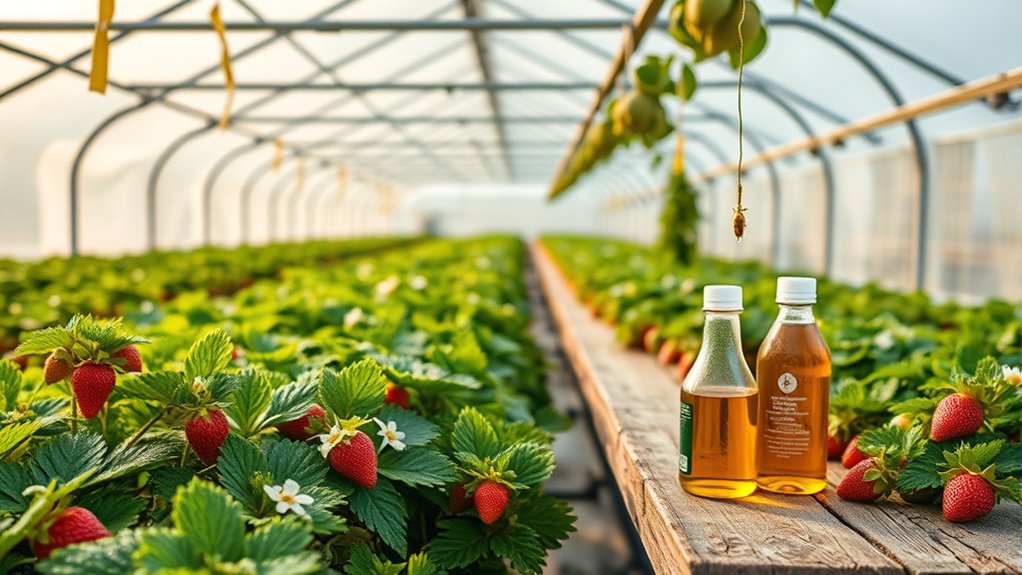
While growing strawberries in a greenhouse can yield delicious results, you'll need to implement pest management techniques to protect your plants from common threats.
Start by regularly monitoring for pests like slugs, spider mites, and aphids. Use organic methods, such as neem oil and insecticidal soap, to keep these invaders at bay. Garlic spray can deter various pests, while citrus-based traps effectively lure and capture slugs.
Consider applying cultural controls like proper irrigation and weed management to minimize pest habitats. Additionally, introduce biological controls, such as predatory mites, to combat spider mites naturally.
Finally, maintain ideal temperatures and humidity levels to discourage pest infestations and promote healthy strawberry growth.
Pollination Methods for Optimal Yield
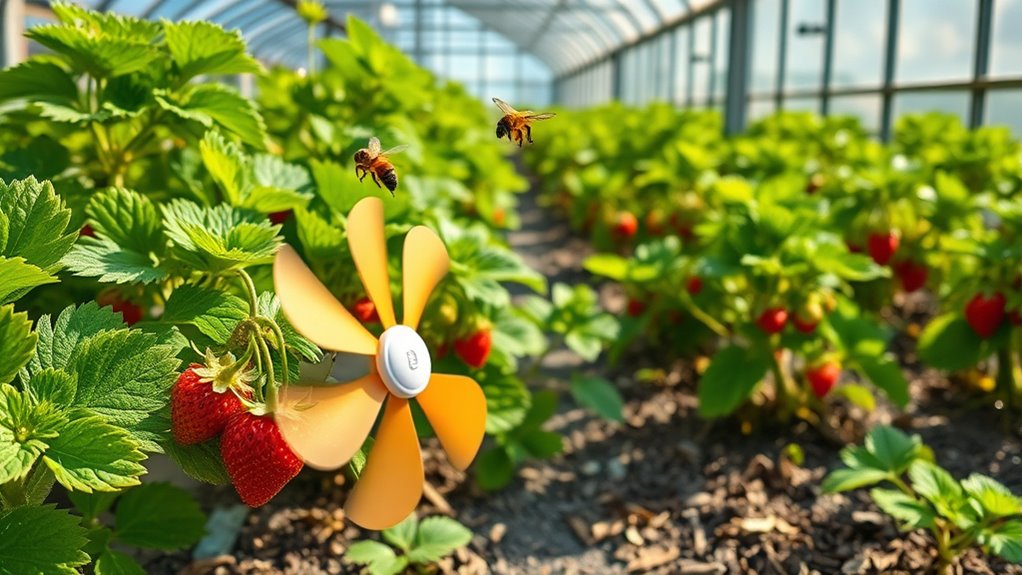
To achieve ideal yield in greenhouse-grown strawberries, understanding and implementing effective pollination methods is crucial.
While strawberry flowers are self-fertile, they thrive with external pollination. Insects, particularly honeybees and bumblebees, greatly boost pollination rates, enhancing fruit quality.
Consider introducing bumblebees into your greenhouse to take advantage of their efficient foraging behavior. To further improve pollination, increase airflow in your greenhouse, allowing pollen to transfer easily between flowers.
You can also use tools like Bonten for hand pollination, mimicking natural processes. Staggering your planting times helps reduce competition for pollinators during peak blooming periods, maximizing your strawberry yield.
Propagation Techniques for Healthy Plants
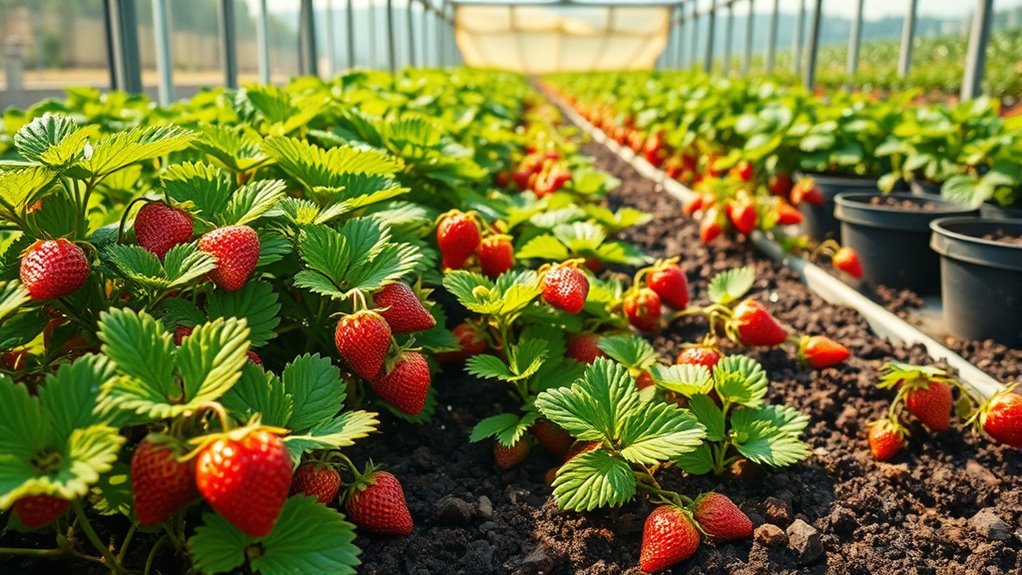
Successful pollination sets the stage for thriving strawberry plants, but achieving healthy growth also hinges on effective propagation techniques.
One popular method is runner propagation, where you allow the natural stolons to root, creating new plants easily. Alternatively, you can grow strawberries from seeds, but remember to stratify them in cold conditions for about three months first.
Plant division is another option; divide mature crowns to rejuvenate older plants, though it requires care to avoid damage.
Tissue culture, while complex and typically for commercial use, produces disease-free, uniform plants.
Finally, choose the right strawberry variety—like June-bearing or day-neutral—to enhance your propagation success and yield.
Each technique has its advantages, so pick the one that suits your needs best.
Best Practices for Maintenance and Care
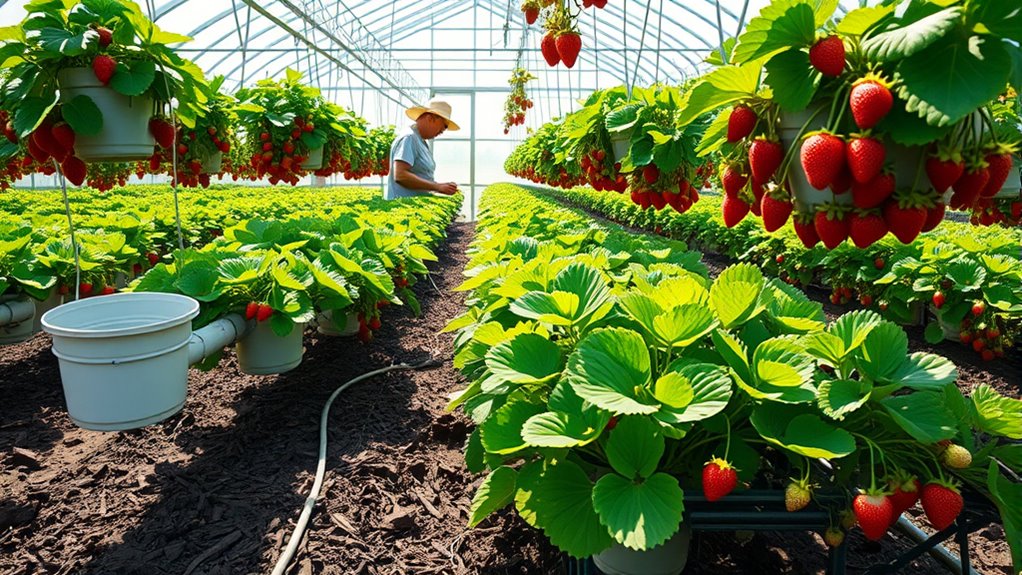
Maintaining healthy strawberry plants in a greenhouse requires attention to several key factors, ensuring they thrive throughout their growth cycle.
Start by providing at least six hours of direct sunlight daily and maintain temperatures between 65°F to 77°F. Use heating systems and grow lights in winter to support growth.
Ensure your strawberry plants receive six hours of sunlight and maintain temperatures between 65°F to 77°F for optimal growth.
For soil, opt for well-draining, fertile mixes with a pH of 5.5 to 7.0, watering at the base to prevent diseases.
Regularly inspect for pests like aphids and slugs, utilizing organic controls when needed.
Fertilize every two weeks, switching to a high-potassium feed during flowering.
Finally, harvest every couple of days and renew plants every three years for continued productivity.
Frequently Asked Questions
How Long Does It Take for Strawberries to Produce Fruit?
It usually takes about 60 to 90 days for strawberries to produce fruit after planting.
You'll notice that fruits typically develop 30 to 45 days after flowering begins.
Keep in mind that the exact timing can vary based on the strawberry variety you choose, like June-bearing or everbearing types.
Can Strawberries Be Grown in Vertical Gardens?
Yes, you can definitely grow strawberries in vertical gardens! They thrive in stackable planters, hanging baskets, or even recycled gutters.
Just make sure each plant gets enough sunlight—at least six hours a day. Use a well-draining potting mix to prevent root rot, and keep the soil consistently moist.
With proper care, you'll maximize your yield in a small space, enjoying fresh strawberries right from your vertical setup!
What Common Diseases Affect Greenhouse Strawberries?
Imagine your strawberry plants as delicate dancers, but they're vulnerable to unseen foes.
Common diseases like powdery mildew and gray mold can crash the party, thriving in humid havens.
Anthracnose and red stele root rot creep in silently, while leaf spots mar the beauty of your green stage.
To protect your harvest, keep a sharp eye out and maintain cleanliness, ensuring your strawberries flourish without the shadow of disease lurking nearby.
How Do I Know When to Harvest Strawberries?
You'll know it's time to harvest strawberries when they're fully red and slightly soft to the touch.
Typically, strawberries take about 30-45 days to mature after flowering. Regular picking every two to three days encourages more fruit production, so keep an eye on them.
For the best flavor, pick your strawberries in the morning when it's cool. This way, you'll enjoy the sweetest, freshest strawberries right off the plant!
Can I Grow Strawberries From Store-Bought Fruit?
You can try growing strawberries from store-bought fruit, but it's not guaranteed to work.
Most store-bought strawberries are hybrids, meaning their seeds mightn't produce true-to-type plants. Additionally, chemical treatments can hinder germination.
If you still want to experiment, extract seeds carefully, dry them, and give them proper conditions for germination.
Just remember, the results can be unpredictable, and you mightn't end up with the same quality of fruit.
Conclusion
To sum up, growing strawberries in a greenhouse can be a rewarding venture. By selecting the right varieties, managing environmental conditions, and ensuring effective irrigation, you can enjoy fresh strawberries year-round. Don't forget about pest management and pollination to maximize your yield. With a bit of care and attention, your strawberry plants will thrive like a rock star at a sold-out concert. So roll up your sleeves, and get ready to dig into this delicious endeavor!




